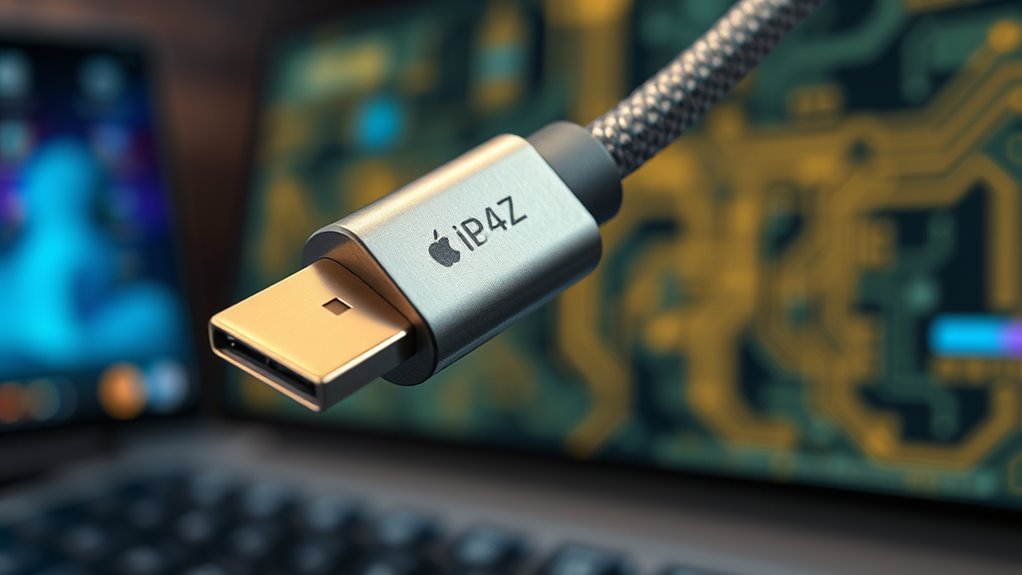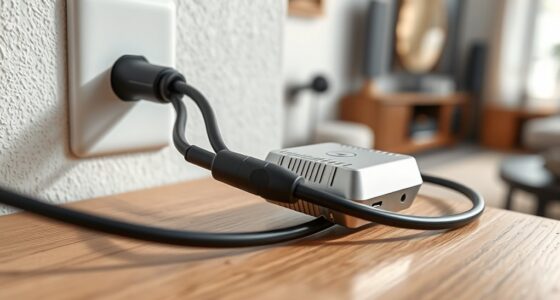USB4 and Thunderbolt 4 are shaping the future of peripheral cables by offering ultra-fast data transfer up to 40 Gbps, robust power delivery, and broad compatibility across devices and platforms. These standards simplify connections with universal USB-C ports, support high-res displays, and improve reliability through durable cables. As they continue evolving, you’ll see more seamless workflows and versatile accessories. To discover how these technologies can enhance your setup, explore the full details ahead.
Key Takeaways
- Thunderbolt 4 and USB4 both deliver up to 40 Gbps speeds, ensuring fast data transfer and versatile peripheral compatibility.
- Thunderbolt 4 cables are more durable and strictly certified, offering enhanced reliability for demanding applications.
- Both standards support universal USB-C connectors, simplifying device connections and future-proofing peripheral ecosystems.
- USB4 provides a more budget-friendly option with high performance, while Thunderbolt 4 emphasizes robustness and professional-grade features.
- The evolving standards enable seamless cross-platform use, wireless integration, and support for high-res displays and external GPUs.
Understanding USB4 and Thunderbolt 4: Core Features and Differences
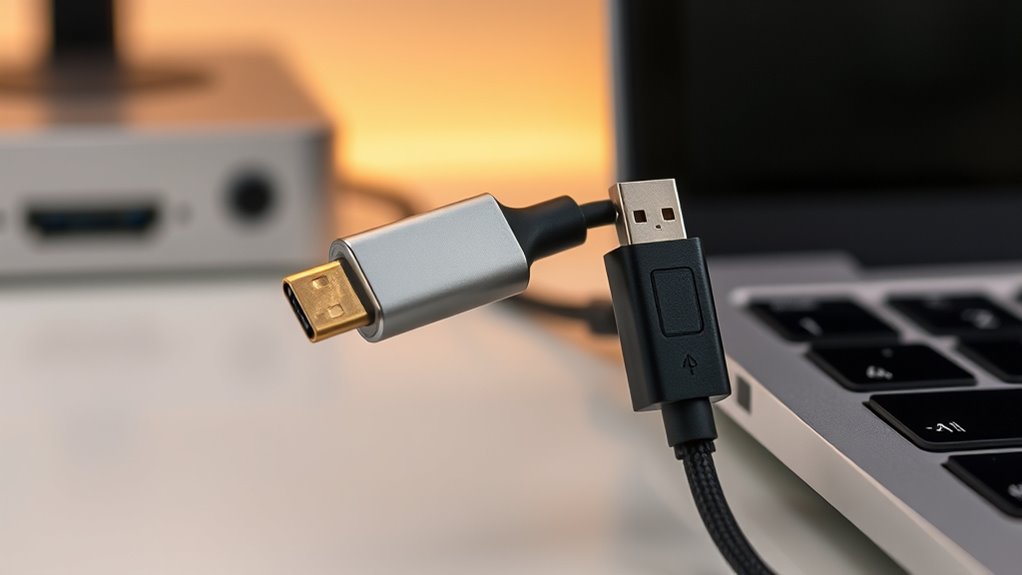
USB4 and Thunderbolt 4 are both high-speed connection standards that enable fast data transfer and versatile device compatibility. When comparing their core features, you’ll find that performance benchmarks play a significant role. Thunderbolt 4 consistently offers higher transfer speeds, up to 40 Gbps, while USB4 can reach similar speeds but varies depending on the implementation. Cable durability is also essential; both standards support robust, well-built cables designed to withstand frequent use. Thunderbolt 4 cables typically feature reinforced connectors and stricter certification standards, ensuring longevity. USB4 cables are also reliable but may differ in quality. Ensuring cable quality is vital for maintaining optimal performance and preventing damage over time. Additionally, interoperability between devices ensures seamless connectivity across different brands and platforms. Both standards also emphasize power delivery, enabling charging of devices directly through the cable, which adds to their versatility. Understanding these differences helps you select cables that deliver maximum performance and durability, ensuring your devices remain efficient and protected over time. Forsale 100
The Technology Behind USB4 and Thunderbolt 4
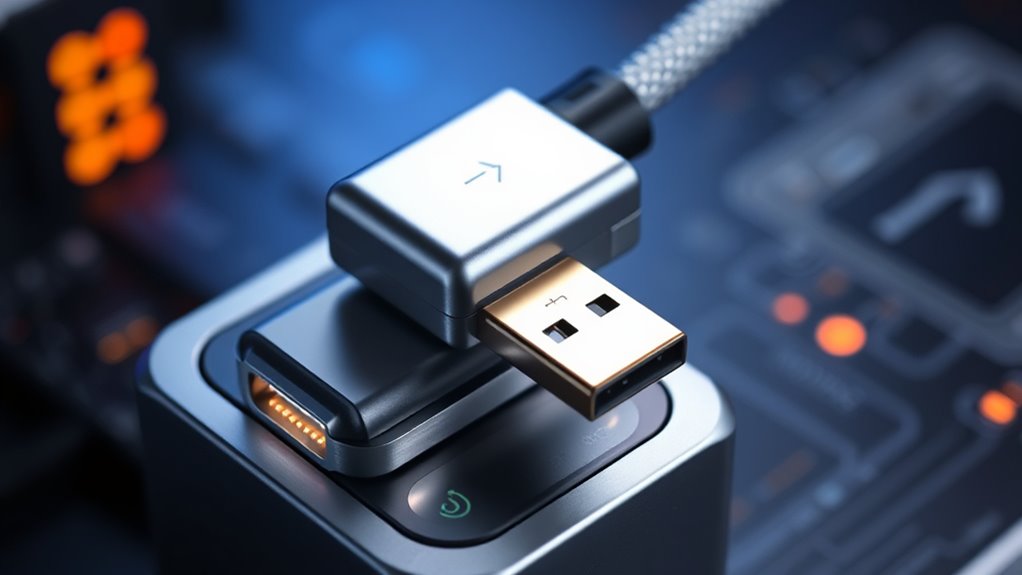
Both USB4 and Thunderbolt 4 are built on the versatile Thunderbolt 3 architecture, which consolidates various data transfer protocols into a single, high-speed interface. This foundation guarantees maximum signal integrity and optimized performance. The technology relies on advanced signal processing to minimize interference and maintain data accuracy. Key features include:
- Enhanced Signal Integrity: Uses sophisticated techniques to prevent data loss and ensure reliable transmission.
- Unified Connector Design: Employs the reversible USB-C connector, simplifying connections across devices.
- High-Speed Data Transfer: Supports up to 40Gbps, enabling rapid data and video transfer with minimal latency.
These innovations make the cables robust, versatile, and future-proof, supporting demanding applications with confidence.
Compatibility and Device Support: What You Need to Know

Understanding device compatibility is vital when choosing between USB4 and Thunderbolt 4, as support varies across different gadgets. You’ll want to take into account how well these standards work across platforms and whether your current devices will stay relevant in the future. Knowing these details helps you make an informed decision and guarantees your setup remains versatile and future-proof. Additionally, vetted products ensure safety and effectiveness when selecting peripherals compatible with these standards. Considering the lifestyle associated with technology use can also influence your choice, as ergonomic and efficient setups contribute to overall productivity and well-being.
Device Compatibility Range
When considering device compatibility, it’s important to know that USB4 and Thunderbolt 4 are designed to work seamlessly with a wide range of peripherals, including external displays, storage devices, and docking stations. Their focus on device diversity guarantees you can connect numerous hardware types without hassle. Additionally, software compatibility plays a vital role, allowing smooth operation across different operating systems. As the hours of operation for many stores vary, ensuring your peripherals are compatible can help avoid potential disruptions during peak shopping times. Here are three key points:
- They support a broad spectrum of devices, from high-resolution monitors to external SSDs.
- Compatibility extends to various operating systems, ensuring versatility.
- They maintain backward compatibility with older USB and Thunderbolt versions, enhancing device support, which is crucial for device support across various technology generations.
This guarantees your peripherals work reliably, no matter the brand or model.
Cross-Platform Support
Cross-platform support is a key advantage of USB4 and Thunderbolt 4, ensuring your devices work seamlessly across different operating systems. With enhanced cross platform compatibility, these technologies make it easier for you to connect peripherals regardless of whether you use Windows, macOS, or Linux. You won’t need to worry about compatibility issues or finding specific drivers, as both standards prioritize universal device support. This means most peripherals—like external drives, displays, and docks—integrate smoothly, saving you time and frustration. Whether you’re setting up a new workstation or upgrading existing gear, USB4 and Thunderbolt 4 provide a flexible, reliable solution to keep all your devices connected and functioning properly across diverse platforms. Additionally, compatibility considerations ensure these standards are designed to work with a wide range of devices and operating systems, further enhancing their versatility.
Future-Proofing Benefits
Future-proofing is one of the key advantages of USB4 and Thunderbolt 4, ensuring your devices stay compatible as technology evolves. These standards support a wide range of devices, so you won’t need to worry about outdated cables or losing device security. To make the most of this, consider these benefits:
- Universal Compatibility: Work seamlessly with new and existing peripherals without purchasing new cables.
- Enhanced Device Security: Better protection against data breaches and unauthorized access.
- Cable Durability: Built for long-term use, reducing the need for replacements and ensuring reliable performance over time.
Additionally, implementing organized storage solutions for cables and accessories can help maintain a clutter-free workspace and prolong the lifespan of your cables.
Speed and Power: Enhancing Data Transfer and Charging Capabilities

Thanks to advancements in USB4 and Thunderbolt 4, data transfer speeds and charging capabilities have seen significant improvements. These technologies enable faster data transfers, reducing wait times when syncing large files or streaming high-resolution content. You’ll also notice more efficient charging, allowing devices to power up quickly while maintaining power efficiency, which minimizes energy waste. The enhanced cable durability ensures your connections remain reliable over time, even with frequent use. With these improvements, you can confidently transfer data and charge devices simultaneously without sacrificing performance or risking damage to your cables. Overall, USB4 and Thunderbolt 4 deliver a seamless experience, combining speed and power in a way that meets the demands of modern peripherals and workflows.
The Impact on Peripheral Devices and Ecosystem Development

The adoption of USB4 and Thunderbolt 4 has substantially transformed the peripheral device landscape and accelerated ecosystem development. You now benefit from a more unified peripheral ecosystem, simplifying compatibility across devices. This shift fuels accessory innovation, enabling manufacturers to create versatile peripherals that work seamlessly with multiple systems. Additionally, the integration of standardized security protocols ensures safer data transmission across these advanced interfaces. Consider these impacts: 1. Standardized connections foster broader accessory development, reducing fragmentation. 2. Enhanced bandwidth supports advanced peripherals like high-res displays and external GPUs. 3. Faster data transfer and power delivery encourage the creation of multifunctional accessories, streamlining your workspace. 4. The availability of unique and wicked planters and other creative accessories demonstrates the expanding range of peripherals designed for diverse user needs. Furthermore, the development of universal compatibility standards promotes a more consistent user experience across different brands and devices. This progress is closely linked to the evolution of dog names and other naming conventions that help differentiate and personalize devices and accessories. Together, these changes empower you with more reliable, innovative peripherals, making your setup more adaptable and future-proof. The evolving ecosystem ensures ongoing improvements and expanded peripheral options.
Future Trends and Potential Innovations in Peripheral Connectivity
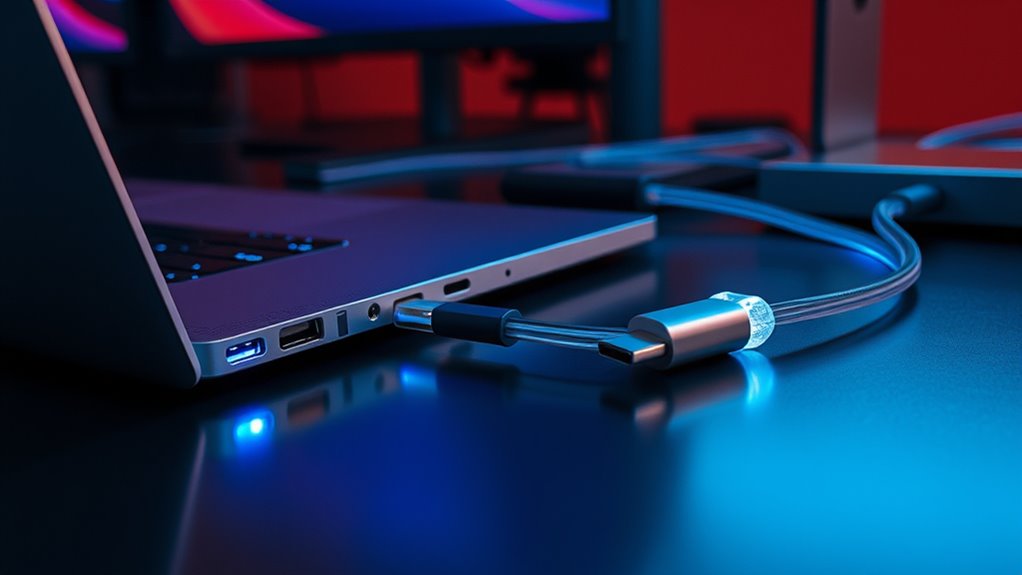
Future peripheral connectivity will likely see wireless options becoming more seamless and reliable, freeing you from cables. You can also expect data transfer speeds to keep improving, making large file sharing faster than ever. These innovations will reshape how you connect and work with your devices daily. Additionally, advancements in high-speed data transfer will enable even more efficient communication between devices, supporting the increasing demands of modern technology. As wireless charging technology improves, expect to see more devices eliminating cords altogether, further enhancing convenience and flexibility. Moreover, integrating ergonomic design principles from related fields like massage chairs and recliners can lead to more user-friendly and adaptable peripheral devices, promoting better energy flow and overall user experience.
Wireless Integration Possibilities
As wireless technology continues to advance, integrating peripherals through wireless solutions becomes increasingly feasible and appealing. You’ll see more devices supporting wireless integration, reducing cable clutter and boosting mobility. To make this happen smoothly, device compatibility is key, ensuring different peripherals can connect seamlessly without issues. Here are some exciting possibilities:
- Improved wireless protocols enabling faster, more reliable connections for peripherals. Enhanced data transfer
- Universal standards that enhance device compatibility across brands and platforms.
- Smart integration with IoT ecosystems, allowing peripherals to communicate effortlessly with other devices.
- Wireless standards are evolving to support higher bandwidths and lower latency, further enabling seamless peripheral connectivity. Additionally, ongoing advancements in peripheral compatibility promote a more unified and versatile user experience.
These innovations promise a future where you’ll enjoy hassle-free wireless connectivity, making your workspace more flexible and streamlined.
Enhanced Data Transfer Speeds
Emerging innovations in peripheral connectivity aim to drastically boost data transfer speeds, making workflows more efficient and responsive. Future trends include integrating faster protocols like USB4 and Thunderbolt 4, which can transfer data at unprecedented rates. You’ll notice improvements in wireless charging capabilities, reducing the need for multiple cables while maintaining high-speed data exchange. This also supports greater peripheral customization, allowing you to connect a variety of devices seamlessly. As transfer speeds increase, expect smoother workflows when moving large files or streaming high-resolution content. Enhanced data speeds will further enable real-time collaboration and lower latency in professional setups. These advancements will ultimately simplify your setup, giving you faster, more versatile connectivity options that adapt to your evolving tech needs.
How to Choose Between USB4 and Thunderbolt 4 for Your Setup
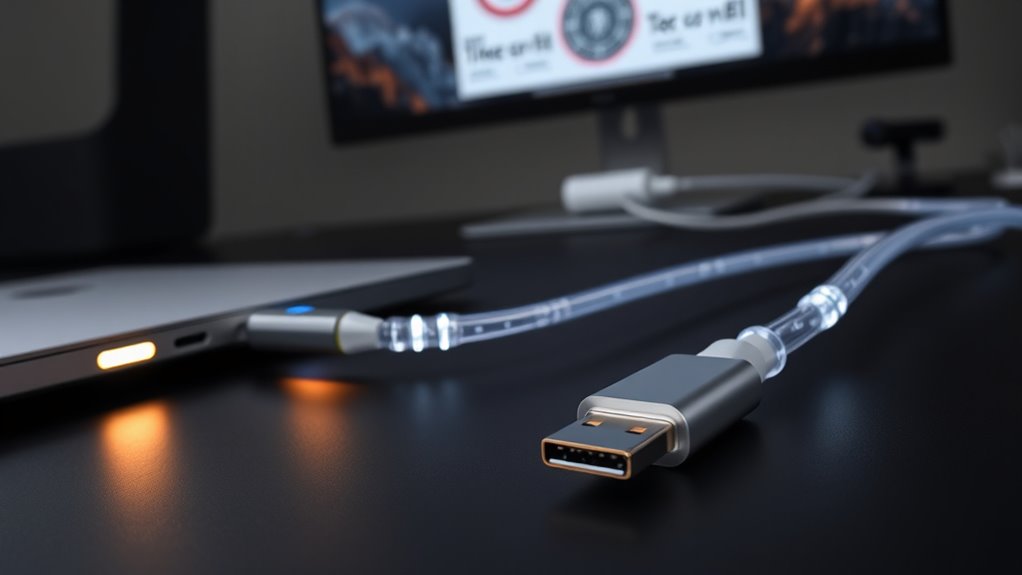
Choosing between USB4 and Thunderbolt 4 depends on your specific needs and budget. Consider how device design and cable durability impact your setup. To help decide:
Choosing USB4 or Thunderbolt 4 depends on your needs, device compatibility, and cable durability.
- Device Compatibility: Check if your devices support Thunderbolt 4 for faster, more versatile connections, or if USB4 suits your basic needs.
- Cable Durability: Thunderbolt 4 cables often have better build quality, lasting longer under frequent use, whereas USB4 cables are generally more affordable but may vary in durability.
- Price and Budget: Thunderbolt 4 accessories tend to be pricier due to advanced features, while USB4 provides a budget-friendly alternative with excellent performance for most users.
- Compatibility with Verified Devices: When choosing cables, consider whether they are vetted to ensure quality and reliability, especially for high-performance setups.
Assess these factors based on your setup’s demands, focusing on device design and cable durability, to make the best choice.
Frequently Asked Questions
Can USB4 and Thunderbolt 4 Cables Be Used Interchangeably?
You can’t use USB4 and Thunderbolt 4 cables interchangeably for all devices because cable compatibility varies. While Thunderbolt 4 cables work with USB4 ports, not all USB4 cables support Thunderbolt 4’s higher speeds and features. To guarantee device interoperability, check each cable’s specifications. Using the correct cable ensures peak performance and avoids potential connection issues. Always verify compatibility before connecting your devices to get the best results.
Are There Differences in Security Features Between USB4 and Thunderbolt 4?
You’ll find that Thunderbolt 4 offers more robust security features than USB4. Thunderbolt 4 uses hardware authentication and encryption protocols to guarantee data protection, making it harder for unauthorized devices to connect. USB4 also includes security measures, but they’re less extensive. So, if security is your priority, Thunderbolt 4 provides stronger safeguards through its advanced hardware authentication and encryption protocols.
How Do USB4 and Thunderbolt 4 Impact Device Durability?
Imagine connecting your device with a sturdy USB4 or Thunderbolt 4 cable, knowing it’s built for connector robustness. These standards enhance device durability by supporting higher-quality materials and better shielding, which reduces wear and tear from frequent plugging and unplugging. As a result, cable longevity increases, lowering the risk of damage. Your devices stay protected longer, and you enjoy reliable performance over time, making your tech investments more resilient.
Will Future Updates Improve Compatibility and Performance?
Yes, future firmware updates will likely improve compatibility standards and boost performance for USB4 and Thunderbolt 4. You can expect improvements that make your devices work more seamlessly together, reducing issues and increasing data transfer speeds. Manufacturers are continuously refining these standards, so staying updated with firmware releases ensures you get the best possible experience with your peripherals, making future connections more reliable and efficient.
Are There Specific Operating Systems That Better Support USB4 or Thunderbolt 4?
You might find that Windows 10 and later versions offer the best support for USB4 and Thunderbolt 4, thanks to robust driver support and frequent updates. macOS also provides solid compatibility, especially with Thunderbolt 4 devices, due to native driver integration. Linux support is improving but can vary depending on the distribution and hardware. Overall, operating system compatibility depends on driver updates and manufacturer support, so staying current helps guarantee ideal performance.
Conclusion
As you plug into the future of connectivity, imagine a sleek cable seamlessly transferring your data like a swift river and powering your devices with ease. USB4 and Thunderbolt 4 open doors to faster, smarter peripherals that make your workspace or entertainment setup feel like a smooth, flowing stream. Embrace these innovations, and let your devices dance in harmony, revealing new possibilities with every connection you make.
